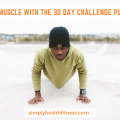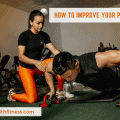The benefits of kettlebell swings are many and varied – but not if you perform them incorrectly.
Performing kettlebell swings perfectly means better results, less injury risk, and a better workout time after time. Today we’re going to touch on the muscles worked in a kettlebell swing, proper kettlebell swing technique, and what mistakes to look out for in your own workouts…
Benefits of the kettlebell swings: what’s it for?
The kettlebell is useful not only because it’s simple, but because it strikes at a mixture of muscle groups and skills, as well as being somewhere between strength and conditioning training.
We can break the benefits of kettlebell swings into the muscular benefits and the movement benefits.
What muscle groups does the kettlebell swing train?
There are 4 major muscle groups that benefit from kettlebell swings, and that make it such a useful full-body movement: the glutes and hamstrings, the core, the upper back, and the forearms.
1. Hip Muscles: Glutes and Hamstrings
The kettlebell swing is, first and foremost, a way of strengthening the muscles involved with extending the hips. These are the glutes and hamstrings, mainly, which are going to be doing all the hard work in a kettlebell swing.
You want to make sure you feel these working during your swings, and you’re definitely going to feel them the next day if you get the movement right.
This is important because these muscles are chronically weak from inactivity, too much sitting, or just unbalanced training. Strengthening them is key to stabilizing the lower back, helping open up the hip flexors, and keeping the hips and knees safe from injury.
2. Kettlebell Swings Build Core Strength
A good kettlebell swing involves a solid midsection, transferring hip power into the kettlebell without any softness in the spine. This is a great way of strengthening the core and lower back together because that’s how they’re meant to work in order to keep the spine safe.
3. Upper Back: Lats, Traps, and Rhomboids
Controlling the kettlebell throughout the swing is going to be a great way of building a stronger upper back. The muscles of the lats, lower traps, and rhomboids all get some dynamic stability work in with a good full-range kettlebell swing.
This is important for posture, both while performing other exercises (like squats or deadlifts), as well as in everyday life.
4. Stronger Forearms and Better Grip
If you’re doing enough reps of a heavy enough kettlebell swing, you’re going to challenge – and improve – your grip strength. This is one main benefit of kettlebell swings but often goes overlooked.
The additional strength training for the wrists and forearms isn’t something many people focus on, but it can be a great way of keeping your wrist and elbow healthy while building titanic grip strength.
Join our 30-day push-up challenge.
Proper Kettlebell Swing Form: What it should look like
A great kettlebell swing only has a few things you need to do well, but they’re make-or-break. Getting all of these right is going to help you squeeze the most out of kettlebell swings in your program.
1. The Swing is a Hip hinge
You need to guide the swing with the hips; the movement should primarily about opening and closing the hip joint. This is the hip hinge – and it’s one of the most important but overlooked aspects of good movement.
You can’t get the maximum benefit of a kettlebell swing without perfecting this movement and a good swing is defined by it.
Your knees should stay in the same place (roughly directly above your heels), your trunk should stay completely neutral through the movement but your hips should move backwards and forwards. There shouldn’t be any movement if the hips aren’t moving and this strong hinging is what gives the kettlebell momentum.
2. A stable, unmoving torso
Any movement in the torso during a kettlebell swing is unnecessary and worth avoiding – you want to make sure that the core is just stabilizing. Movement in the spine under dynamic loading is one way of increasing your injury risk, but also takes the emphasis off the muscles of the hips.
You should be able to watch a video of your kettlebell swing from the side with no movement in the torso.
It’s a simple idea but can take some time and practice to get used to, so don’t rush this – all movement comes from the hips.
3. Control above the navel
You need to keep control of the weight from start to finish – but especially as it passes the belly button. From this point up – however high your swing goes – controlling the balance, tempo, and the distance from your body to the kettlebell is crucial.
Here at the top it’s important you don’t let the kettlebell decide where you’re going. It’s an easy area to get things wrong, and you want to keep the same kind of control and movement-focus that we’ve pushed for across the whole movement.
Keep your weight balanced through the mid-to-rear of the foot and keep the hips extended, easing the kettlebell up and cushioning it back down as it falls below shoulder height again.
4. Smooth from start to finish
The kettlebell swing should look smooth and effortless – you want the same kind of quality movement from start to finish. The last thing you want is jerky movement during a hip exercise, and especially one where there’s a lot of dynamic movement, like a kettlebell swing.
Try to maintain a smooth and controlled pace from start to finish, especially at the bottom where lack of control can tip you over, round your back, or cause you to stumble.
Again, practice is key here, and it’s not important what weight you’re using for movement practice. Take the time to get it right and then load afterwards, or you’re just increasing the how heavily you can get the exercise wrong.
Common kettlebell swing mistakes
On the other hand, it’s easy to make simple mistakes and you need to keep your eyes out for these when you’re performing kettlebell swings. These are things you want to tweak over time to keep improving and make the most of your swings.
1. Bending the knees: squatting the swing
You should bend the knees slightly before you start swinging, but from there they shouldn’t be doing the work. You don’t want to squat your swing; the knees should stay in one place while the hips do all the work.
This is as simple as focusing on keeping the knees in the same place and sitting back into the swing, rather than down.
2. Rounding the back: major injury risk
Rounding your back is a cardinal sin in weight training; it should only be performed when an exercise specifically calls for it. During a kettlebell swing, you’re loading the spine and moving dynamically, as well as performing relatively high reps.
If you keep your back round through this exercise you’re going to compound your risk of injury greatly. Get your core set and keep the whole trunk completely stable throughout. As above, the hips should be doing the movement.
This is one of the main causes of kettlebell swing lower back pain, so be diligent with your torso – once you’ve practiced it for a while, it should become natural to keep your torso in the right position.
This is usually just a case of practice, discipline, and using the right weight for your strength/experience.
3. Losing control: jerky, dangerous movements
If you lose control of the kettlebell at any point in the movement then something is wrong. You should be producing a smooth and effortless-looking movement that moves from the top to bottom position and back without too much jerking.
It’s a swing; we want it to look like a pendulum moving smoothly from one side to the other. This is crucial at the bottom position, where injury risk is higher, and at the top where control is a little more difficult due to the position of the kettlebell relative to your centre of balance.
Take your time and practice the rhythm of the swing to make sure you’re controlling these two key areas, or you’re going to get less from the exercise, along with greater odds of injury.
Alternatives to kettlebell swings
Not everyone is going to be ready for a perfect swing right away, and sometimes regressing to a simpler exercise is the smart choice in the short-term.
This can help you to get familiar with the movement, build basic strength, and prep for the dynamic strength/conditioning effects of a kettlebell swing.
Alternatives to kettlebell swings take the dynamism or weight out of a kettlebell swing and work on the individual aspects – the muscle groups and skills mentioned above – in a simpler scenario. This makes it easier to perfect your kettlebell swing technique without struggling with the reps/weight.
Here are a few simple exercises you can use to build up this familiarity.
1. Hip hinge drill
Practice your hip hinge.
It will never be a bad time to improve it or get re-acquainted – it’s a key to good movement in so many exercises.
The simple dowel hip hinge is one of the best ways you can practice and improve with no weight.
Alternatively, you can perform hip hinges with the kettlebell behind the back to help you get a better feeling for the movement.
If you get this right, and insist on this same movement with your swings, you’ve got a great foundation already.
2. Good Mornings
Good mornings – and goblet good mornings – help to practice the movement of a hip hinge with either no, or little, weight. They can help to cue the bum-back movement, while also challenging you lightly to keep the core stable and engage the hips/hamstrings.
If you’re struggling to get your swing together, this can be a helpful entry-level movement to practice hinging and build simple strength.
3. KB RDL
Romanian deadlifts are like good mornings, but with the weight at arms’ length like in a kettlebell swing. This is a movement where you can develop more strength and control, as well as strengthening the muscles. This can be performed with a heavier weight than the good morning.
It’s a great in-between for the good morning and the swing, helping to build familiarity with the balance of the body and kettlebell together.
4. Hinge to vert jump
If you’re struggling to get your hinge smooth and powerful, you can work on the patter without the weight. Take a normal kettlebell swing movement, hinging the hips back and reaching down to the floor, before reversing the movement into a small vertical jump.
Spend time practicing this to build balance and control the tempo. This is going to be useful if the dynamic stability is where you struggle.
Obviously, pair this with the weighted movements mentioned above and make sure to slowly progress through kettlebell weights, when you use them, to improve your confidence and strength.
Final Thoughts
There are many benefits of kettlebell swings, but they come from combining the movement-practice and muscle/conditioning effects. Perfecting your kettlebell swing technique helps to make the most of these benefits, reduce risks of injury and make them a well-rounded part of your training.
Do we need this section as, the sections seem to be repeated in the section below?
It’s just important to set out what we’re going to refer back to throughout the piece. I can remove it, but I think it’s important to the continuity of the piece.




